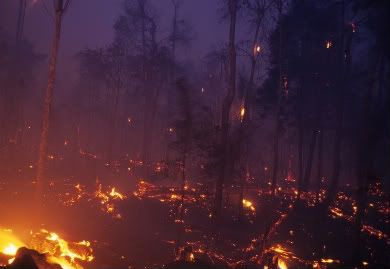Global warming aided by drought, deforestation link - carbon released by forest fires equal to fossil fuel emissions in equatorial Asia

In 2006, the climate on the fast-developing islands of Borneo and Sumatra and in New Guinea and other parts of equatorial Asia was three times drier than in 2000, but carbon emissions from deforestation were 30 times greater – exceeding emissions from fossil fuel burning.
Land managers respond to the drought by using fire to clear more land. In dry years, they burn deeper into the forest, which in turn releases more carbon dioxide, said James Randerson, climate scientist at UC Irvine and co-author of the study, published online the week of Dec. 8 in the Proceedings of the National Academy of Sciences.
The findings, Randerson says, illustrate why limits on deforestation should be a critical part of future climate agreements. Global warming modelers typically consider climate and land use separately when assessing how changes will affect greenhouse gas emissions:
 energy :: sustainability :: biomass :: bioenergy :: climate change :: deforestation :: fire :: carbon emissions :: drought :: South East Asia ::
energy :: sustainability :: biomass :: bioenergy :: climate change :: deforestation :: fire :: carbon emissions :: drought :: South East Asia :: The results also indicate that forecasting drought may be important when countries in this region allocate resources to combat illegally set fires and clearing.
The link between drought and deforestation is very sensitive, Randerson said. If the climate warms and there are more droughts, it potentially makes the forest and its stored carbon more vulnerable.
Equatorial Asia is a hot spot for biodiversity but is undergoing widespread changes. Its global markets are growing, as is large-scale agricultural business. Forests and peatlands in the region store tremendous amounts of carbon, keeping it out of the atmosphere where it can turn into carbon dioxide and create warming.
The climate in equatorial Asia changes substantially from year to year and is linked with El Nino. Dry years occurred in 2002 and 2006; wet years in 2000 and 2005.
In a dry climate, fires are easier to set and burn more deeply into organic soil. When there is a lot of rainfall, fires don't burn as well, and it is more challenging to remove debris from areas that are being converted to agriculture, said Randerson, associate professor of Earth system science.
Randerson and his colleagues used several kinds of satellite data to develop and refine their emission estimates. First, they used satellite images of fire areas and additional information about carbon pools to estimate emissions from the region. Next, they sharpened their estimate using measurements of atmospheric carbon monoxide levels, which can be a strong signal of fire activity. In a final step, they used both carbon monoxide and satellite data to determine total carbon emissions.
Deforestation and carbon emissions are substantial and important contributors to the buildup of greenhouse gases in the atmosphere, Randerson said. "We should not neglect this flux in developing comprehensive approaches for stabilizing climate."
In addition to Randerson, scientists who collaborated on the study include G.R. van der Werf and A.J. Dolman of VU University Amsterdam; J. Dempewolf and D.C. Morton of the University of Maryland; S.N. Trigg of Cranfield University in the United Kingdom; P.S. Kasibhatla of Duke University; L. Giglio of Science Systems and Applications, Inc.; D. Murdiyarso of the Center for International Forestry Research in Indonesia; W. Peters of Wageningen University and Research Center in the Netherlands; G.J. Collatz of NASA Goddard Space Flight Center; and R.S. DeFries of Columbia University.
This work was supported by NASA and the Netherlands Organization for Scientific Research.
Picture: A fire in a tropical peat forest on Sumatra in Indonesia. Credit: Florian Siegert.
References:
PNAS Article not yet online at time of release of this text.
 --------------
--------------
 Taiwan's Feng Chia University has succeeded in boosting the production of hydrogen from biomass to 15 liters per hour, one of the world's highest biohydrogen production rates, a researcher at the university said Friday. The research team managed to produce hydrogen and carbon dioxide (which can be captured and stored) from the fermentation of different strains of anaerobes in a sugar cane-based liquefied mixture. The highest yield was obtained by the Clostridium bacterium.
Taiwan's Feng Chia University has succeeded in boosting the production of hydrogen from biomass to 15 liters per hour, one of the world's highest biohydrogen production rates, a researcher at the university said Friday. The research team managed to produce hydrogen and carbon dioxide (which can be captured and stored) from the fermentation of different strains of anaerobes in a sugar cane-based liquefied mixture. The highest yield was obtained by the Clostridium bacterium.








0 Comments:
Post a Comment
Links to this post:
Create a Link
<< Home